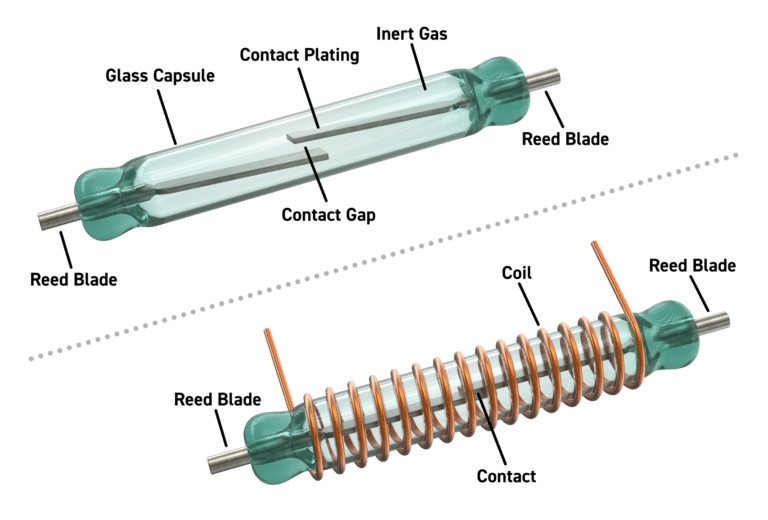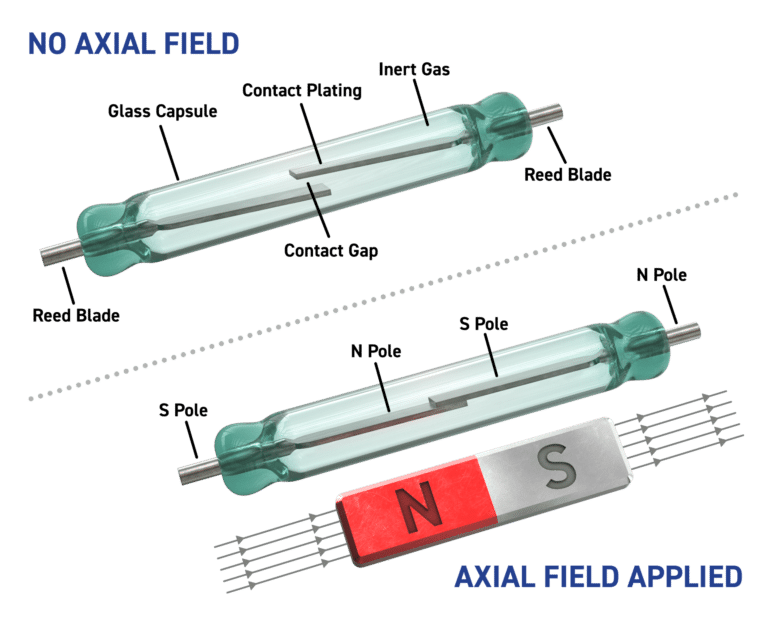An introduction to Reed Relay basics (Part 1):
Reed Relay Basics
Introduction
Reed relays contain a reed switch, a coil for creating a magnetic field, an optional diode for handling back EMF from the coil, a package and a method of connecting the reed switch and the coil to the outside of the package. The reed switch is a simple device and relatively low cost to manufacture.

The reed switch explained:
The reed switch has two shaped metal blades made of a ferromagnetic material (roughly 50:50 nickel-iron) and a glass envelope that serves to both hold the metal blades in place and to provide a hermetic seal that prevents any contaminants from entering the critical contact areas inside the glass envelope. Most (but not all) reed switches have open contacts in their normal state.
If a magnetic field is applied along the axis of the reed blades the field is intensified in the reed blades because of their ferromagnetic nature, the open contacts of the reed blades are attracted to each other and the blades deflect to close the gap. With enough applied field the blades make contact and electrical contact is made.

The only movable part in the reed switch is the deflection of the blades, there are no pivot points or materials trying to slide past each other. The reed switch is considered to have no moving parts, and that means there are no parts that mechanically wear. The contact area is enclosed in a hermetically sealed envelope with inert gasses, or in the case of high voltage switches a vacuum, so the switch area is sealed against external contamination. This gives the reed switch an exceptionally long mechanical life.
Another design variable on the reed switch is its size. Longer switches do not have to deflect the blades as far (measured by the angle of deflection) as short switches to close a given gap size between the blades. Short reeds are often made of thinner materials so they deflect more easily but this clearly has an impact on their rating and contact area. Smaller reed switches allow smaller relays to be constructed – an important consideration where space is critical. The larger switches may be more mechanically robust and have greater contact area, improving their signal carrying capability.
Generating the magnetic field:
To create a relay a magnetic field needs to be created that is capable of closing the reed switch contacts. Reed switches can be used with permanent magnets (for example to detect doors closing) but for the reed relays the field is generated by a coil which can have a current passed through in response to a control signal. The coil surrounds the reed switch and generates the axial magnetic field needed to close the reed contacts.

Different reed switches require different levels of magnetic field to close the contact, and this is usually quoted in terms of the ampere turns (AT) – simply the product of the current flowing in the coil multiplied by the number of turns. Again this creates a great deal of variation in the reed relay characteristics. Stiffer reed switches for higher power levels or high voltage switches with larger contact gaps, usually require higher AT numbers to operate, so the coils require more power.
The use of different wire gauges for the coil and number of turns creates relays with different drive voltage requirements and different coil powers. The resistance of the wire coil controls the amount of steady state current flowing through the coil and therefore the power the coil consumes when the contacts are closed. Whenever fine wires are used in Pickering relays, the termination leads from the coils are skeined with several strands of wire twisted together to increase their physical strength.
Larger coils can be used to reduce power consumption, but that increases the size of the relay.
Part Two will continue to explain the wonders that are reed relays, including information on changeover reed switches and two pole relays.
Looking to browse our Reed Relay range?
From high voltage reed relay options to surface mount relays, find out more about our reed relays here






